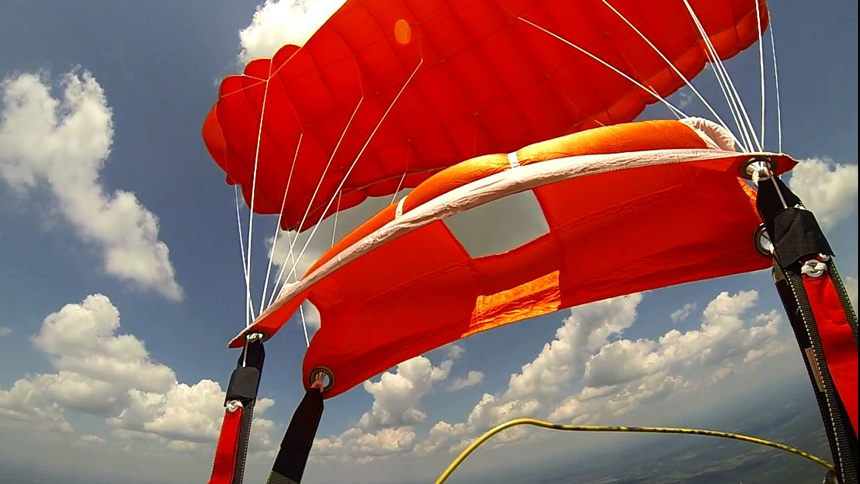You’ve cut away your main, you have a reserve canopy flying, woo hoo.
Now what?!!

Photo by Maxine Tate
When was the last time you flew your reserve?
Check out this suggested dive flow for your reserve ride from reserve deployment back down to earth…
There has been a lot of discussion over the last years on when to cut away, along with how to stay current with emergency procedures – all vitally important stuff. But what happens after you have successfully jettisoned your main – how much thought have you given to that?
Much as we have a tendency to focus on the importance of freefall in the skydive without much consideration to the canopy flight, we have been focusing on the cutaway without discussing how we bring ourselves back down to earth safely under our reserve canopy… So, here is a suggested dive flow for your reserve ride from reserve deployment to ground zero:

Photo by Maxine Tate
No Line Twists
First things first – your reserve is out, hopefully fully inflated and without line twists. (Show some love to your rigger later :)) If not, make it so, there is no Plan C.
There is no Plan C”
TAP check
What’s next? As you would do with your main, go through your post deployment checklist as follows:
TAP – Traffic, Altitude, Position
Traffic
Make sure your airspace is clear- scan around you quickly and if needed make the necessary avoidance maneuvers immediately using your reserve rear risers.
Altitude
Check your altitude – do it now!!! Look down – if you are dangerously low your eyes will tell you instantly. Look at your visual altimeter for a more accurate reading – you could well be low after a cutaway, so it’s time to assess (for example are you still above pattern entry height?).
Position
- Where am I and can I make it back to my intended landing area?
- If not what is the best alternate landing area?
- Do I have enough altitude to make it there?
- Are there any obstacles that I need to avoid in the chosen landing area?
- What is my landing direction?
- Can I still fly a pattern to increase my chance of accuracy on landing?
Once you’ve answered these quick-fire questions you should have a strategy for the rest of your descent. It may just be a matter of 10 seconds or less to get this done, but it’s vital to have a process and consequently to generate a plan to work with.
While you are answering these important questions release your brakes and pull down evenly to go straight into a slower flight mode: firstly it will avoid the system surging forward into full flight after brake release when altitude may be in short order, secondly this will slow your descent rate even further than toggles stowed, and thirdly it will give you more valuable thinking time. Don’t forget that reserve toggles are stuck with velcro to the reserve risers. As our reserve canopies are not used very often the velcro is normally in excellent condition, so you will need to peel upwards first (like you just did with your cutaway handle) before pulling the toggles down simultaneously in order to have a smooth symmetrical brake release.

Photo by Maxine Tate
Relax
Take a breath… Try to be calm and focus… You’ve got this…
Be calm and focus… You’ve got this…
What’s probably going through your mind next is ‘when is the last time I landed this reserve/a 7-cell/a canopy this small?’ See how to build confidence below. If altitude permits it’s time to execute a couple of practice flares – the most important goal being to assess where you need to flare to in order to achieve level flight (your sweet spot) also known as Landing Priority Number 1 – land with the wing level flying horizontally above your head. You all knew that, right? (If not see my Landing priorities article) Remember a different canopy will likely result in a different sweet spot but always execute a strong symmetrical finish to your flare.

Photo by Maxine Tate
TAP Check 2
- Traffic – is my airspace still clear?
- Altitude – what is it, am I still on track to execute my plan?
- Position – am I still heading to my desired pattern entry point (if feasible)?
Heads Up
When assessing your altitude and position bear in mind that up to three factors may have changed since swapping your main for your reserve – canopy type, size and wing loading. All of these will affect your descent rate, and may as a result make the descent feel a little less familiar than under your main. If you need more decision time don’t forget you can continue to choose to fly in brakes to slow your descent rate. Under these circumstances a slow flight mode really can be advantageous.
Hopefully by now you should have a clear handle on where to land, how you are going to approach it and how to execute it. Fly a full pattern if you can. If you are landing in similar airspace to other pilots, join the pattern in an orderly and predictable manner.

Have Confidence
Time to bring this home…
Remember it’s a canopy – you control it – it does what you tell it to, so land it with confidence. Implement the same decisive flare technique you do every time you land your main then give yourself the kudos for having dealt with a cutaway successfully once you’re on the ground.
Still feeling a little shaky on the ‘land with confidence’ part? Here are some suggestions on how to build confidence for that post cutaway landing:
1. Have you ever jumped your reserve?
If your answer is no/not much then Demo it! Why wait until a cutaway to fly your reserve? Go to the demo tours and ask your canopy manufacturer to hook up a demo of the exact same reserve you have but configured as a main, so you can make some dedicated low altitude jumps to familiarize yourself with the flight characteristics of your life-saving device.
If you had a cutaway on your next jump would your reserve be the smallest size canopy you’ve ever landed?”
2. If you had a cutaway on your next jump would your reserve be the smallest size canopy you’ve ever landed?
If the answer is yes then it’s not surprising you lack confidence – consider upsizing! Why would you choose to downsize on the one jump where you are potentially low, out of position and possibly feeling the pressure? The good news is that nowadays the canopy manufacturers have low bulk reserves on offer (such as PD’s Optimum) that will enable you to upsize and still fit in your own container without giving your rigger a heart attack. Contact your container manufacturer for a sizing chart to see what will work for your particular container size and choice of low bulk reserve.
As is the case with every aspect of canopy flight, be proactive in being current. Don’t wait until a cutaway to acquaint yourself with your reserve. And as always – plan the dive, dive the plan ALL THE WAY to the ground.
Flight-1
If you want to learn more about sweet spots, landing patterns, choosing alternate landing areas, flare technique or any other aspect of canopy flight, you can join a Flight-1 canopy course near you, see Flight-1 canopy course map for details.



